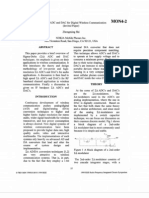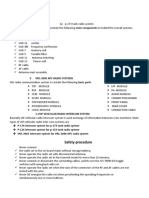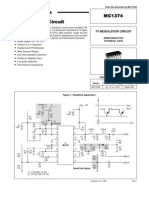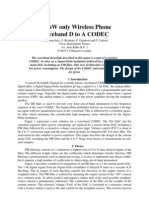24 GHZ FMCW Radar
24 GHZ FMCW Radar
Uploaded by
Lê Đình TiếnCopyright:
Available Formats
24 GHZ FMCW Radar
24 GHZ FMCW Radar
Uploaded by
Lê Đình TiếnOriginal Description:
Original Title
Copyright
Available Formats
Share this document
Did you find this document useful?
Is this content inappropriate?
Copyright:
Available Formats
24 GHZ FMCW Radar
24 GHZ FMCW Radar
Uploaded by
Lê Đình TiếnCopyright:
Available Formats
A Single-Chip 24 GHz SiGe BiCMOS Transceiver for Low Cost
FMCW Airborne Radars
Dave Saunders1, Steve Bingham1, Gaurav Menon1, 3, Don Crockett1, Josh Tor1,
Ralph Mende2, Marc Behrens2, Nitin Jain3, Angelos Alexanian3, 4 and Rajanish3
1
US Monolithics, Gilbert, AZ, 85233, USA
Smart Microwave Sensors, Braunschweig, 38106, Germany
3
Anokiwave, San Diego, CA, 92130, USA
4
RFmaker, Somerville, MA, 02144, USA
Abstract The design and measured results of a highly
integrated FMCW radar transceiver are presented. The
transceiver includes a transmitter with +7dBm output power
and -82 dBc/Hz phase noise at 100 kHz, dual I/Q receivers
with 10dB NF and 18 dB gain, PLL, 15-bit DAC,
instrumentation amplifiers, LDO regulators, and a serial
programming interface all designed to operate from -40 to
+125C at 3.5V, 275 mA. Fabricated using Jazz
Semiconductors 0.18 m SiGe BiCMOS process and
packaged in a 32-pin 5 mm x 5 mm QFN, this RFIC has the
highest level of integration at 24 GHz known to the authors.
Index Terms CW radar, Chirp radar, digital-analog
conversion, FM radar, operational amplifiers, radar
receivers, radar transmitters, airborne radar, phase locked
loops, voltage controlled oscillator.
I. INTRODUCTION
Military aircraft manufacturers employ radar sensors to
enable features such as all-weather landing, weapons
control, altimeter, reconnaissance, and navigation. These
multiple applications are normally not satisfied by the
same sensor, making it imperative that each sensor be low
cost, be reliable under all environmental conditions, be
packaged in a small volume, consume low power, and
require little or no post installation alignment. Narrowband
radars in the 24 GHz ISM band are ideal for these
applications, having world-wide spectrum availability,
little degradation from radome material, and significantly
lower cost compared to higher frequency devices. By
modulating the transmitted signal with a combination of a
linear discrete frequency ramp and frequency shift keying
while simultaneously receiving the reflected signal,
accurate measurements of range, range rate, and azimuth
angle of reflectors (two antennas are used) can be
performed in short measurement cycles [1]. When the
relative velocity of the neighboring targets is zero with
respect to the transmitter, the frequency of the reflected
signal is identical to the transmitted frequency. Therefore,
a practical radar sensor must show excellent transmitter-to-
receiver isolation and very low noise at frequencies of only
a few Hertz for maximum sensitivity for distances from a
few meters to hundreds of meters.
The current solution for FMCW radars is to use multiple
chips in which the transmitter and receiver are on separate
die and enclosed in separate metal cavities or to use a
complete discrete implementation based on GaAs
components. Also, in most cases, the oscillator-PLLreference crystal is placed on a different circuit in a
shielded cavity. These do not lead to a low cost solution
and most important, require extensive calibration over
manufacturing runs. The goal of this work was to build a
highly integrated single-chip FMCW transceiver with all
the necessary components on a single-chip and with
adequate transmit-to-receive isolation. This has lead to a
significantly higher performance and lower cost solution
than available prior to this work.
II. SINGLE CHIP SOLUTION
The system-level architecture of the transceiver, shown
in Fig. 1, includes a transmitter with adjustable output
power, dual direct conversion receivers with adjustable
gain, an on-chip voltage controlled oscillator, an internal
DAC for frequency control, a PLL with instrumentation
amplifier for frequency calibration, a serial programming
interface, low drop out DC voltage regulators, and ESD
protection all designed to operate over a temperature
range from -40 to +125C. Shown in Fig. 2, the fully
functional transceiver die including all pads, can be
packaged in a standard 5 mm x 5 mm plastic 32-pin QFN.
A. Transmitter
The transmitter operates in the 24 GHz ISM band.
Within this frequency band, peak emission levels of 20
dBm EIRP are allowed under ETSI rules [2] and 32.7
dBm EIRP under FCC rules [3]. Used in conjunction with
an antenna gain with from 16 to 26 dBi, the RFIC power
LPF
AMP
Cap
Select
Fine
Tune
Coarse
Tune
DAC
VCO
Counter
A/B/R
SPI
TX
VCO
24.125 GHz
AMP
0 90
DAC
PA
x4
PLL Enable
Control
Bits
PLL
INST. AMP
Rx Gain
RX2
LPF
I2
Q2
Fig. 1.
Tx
Gain
Gain
Adjust
AMP
Vreg
SPI
Tx Enable
6.03125 GHz
PLL
Lock
LO1
0 90
Vreg
RX1
Rx Gain
LO2
Vtune
LNA
LPF
VREG
I1
Q1
LNA
LPF
MMIC Architecture Diagram
amplifier is based on a standard cascode topology and is
required to generate over +6 dBm output power. To
accommodate different antenna gain for various
applications and compensate for temperature variation, the
output power can be reduced in steps of less than 1 dB.
The transmitter can be muted with more than 50 dB of onto-off isolation.
B. VCO, x4 Multiplier, and DAC
The 6 GHz VCO is based on a differential crosscoupled design with a bank of switched capacitors to
compensate for process variation. A low noise PTAT and
a 3.1V regulator were used to ensure circuit performance
over PVT. The VCO output is fed to both the PLL and a
two-stage x4 active multiplier used to translate the VCO
output to 24 GHz. A low noise 15-bit DAC is used to
generate a tightly controlled tuning voltage allowing the
frequency to be digitally swept with a resolution of less
than 25 kHz over a frequency range exceeding 200 MHz.
With this tuning range, process compensation, and dc
regulation, the VCO maintains excellent 1/f noise and
achieves a phase noise spectral density of -82 dBc/Hz at
100 kHz offset at 24 GHz with only slight degradation
over temperature. Frequency chirps covering the full ISM
band can be commanded with step times < 100 s.
C. I/Q Receivers
Two direct-conversion receivers are based on a cascode
design with emitter degeneration inductors to achieve
required gain with low noise and high linearity. The
performance at 24 GHz shows 18 dB gain, 10 dB noise
Fig. 2.
MMIC Die Photograph
figure, and -15 dBm input P1dB. The receiver chain
includes a variable gain amplifier with a gain step of 10
dB. The low noise amplifiers feed into the RF port of
Gilbert cell mixers while the LO port is driven by a
buffered version of the transmitted signal. The I/Q network
is implemented using a LC passive filter while the RF path
has a standard T-junction divider with controlled
impedances. The I/Q phase error is +/-5 deg. over all
conditions. The IF ports are DC coupled with a bandwidth
of 250 MHz.
D. PLL
The PLL provides a means of calibrating the output
frequency of the VCO without the need for a second high
frequency oscillator or second frequency reference (patent
pending). The PLL includes a programmable reference
divider, phase frequency detector, charge pump, dual
modulus prescaler, and programmable A/B counters. The
loop filter uses off-chip components due to the large
capacitance needed. The PLL can lock at 0.5 MHz
intervals across the full ISM band. An on-chip lock
detector with a discrete output allows the PLL control to
be monitored.
E. SPI
The digital serial programming interface provides a
standard interface for configuring gains, operating
frequency, and process compensation. The three-line
control uses 16-bit transfers with multiplexed address and
data bits. Secondary registers store more than 60 control
bits, allowing the output power, frequency, and receive
gain to be controlled over a standard interface during
sensor operation.
F. Implementation
The chip was designed in the Jazz SBC18HA with 6
metal layers. The process is based on a 0.18um SiGe
transistor with an FT of 150 GHz. The inductors,
transmission-lines and pads are placed on the top metal
layer (metal 6, 2.8 um aluminum) in balanced-like
transmission line configuration. All critical inductors and
transmission-lines are modeled using full EM simulations
[4] with user defined shields. The S-parameters were
placed in the design files and simulated with standard Jazz
models for the transistors and other passive devices.
G. Packaging
The chip was packaged in a standard 32-pin QFN plastic
package. The bond-wire inductance and the differential
transitions between the chip and the RF board were
simulated using HFSS [5], and compensated using internal
matching networks. Rat-race couplers translate the singleended antenna ports to differential lines. Bias decoupling
capacitors and IF (radar) shaping filters are included on
the RF board.
IV. RFIC TEST RESULTS
Testing of the RFIC has been performed on wafer, on
packaged parts, in RF front-end testing in an anechoic
chamber, in automotive sensors during test drives, in
security sensors for securing perimeters of prisons or high
value facilities, and as an altimeter on an unmanned aerial
vehicle. Die level testing used a wafer probe station with
temperature controlled chuck to obtain performance data
over a temperature range of -40C to +125C. A photo of
the probe station is shown in Figure 4a. Package level
testing was performed using a plunge-to-board, high
frequency socket as shown in Fig. 4b. Test data was also
taken with the packaged part assembled onto an RF frontend (see inset of Fig. 4c). The RF front-end testing was
performed over temperature in an anechoic chamber as
shown in Fig. 4c and has undergone high temperature life
testing at 105C for 2000 hours. The back side of the RF
front-end printed circuit board includes three planar
microstrip antenna arrays one transmit array (19 dBi)
and two receive arrays (12.2 dBi), which interface to
antennas at the top of the chamber.
A. Transmitter Output
The transmitter output power and phase noise are shown
in Fig. 5 and Fig. 6. The measured output power at 24
GHz, which ranges from 23 to 24 dBm EIRP at 23C, has
Fig. 4. Test stations used for performance verification: a)
wafer probe station showing quadrant probe (top), b) socket test
board (middle), and c) RF front end station with circuit board
inset
only 1 dB variation over the full 24 GHz ISM band and
only a 3 dB of variation over the full temperature range.
The phase noise at 100 kHz offset from a 24.125 GHz
carrier varies from -80 to -83 dBc/Hz over the full
temperature range.
105C, LoGain
105C, HiGain
-40C, LoGain
-40C, HiGain
23C, LoGain
23C, HiGain
-84
25.0
24.5
-88
Sensitivity (dBm)
24.0
EIRP (dBm)
23.5
23.0
22.5
22.0
-92
-96
-100
21.5
21.0
105C
20.5
20.0
24.025
-40C
-104
23C
24.025
24.075
24.125
24.175
24.225
Frequency (GHz)
Phase Noise Spectral Density (dBc/Hz)
Fig. 5. Transmit power vs. frequency over the full temperature
range. Data was taken using test set-up shown in Fig. 4c.
-40C
23C
-70
-80
-90
-100
-110
10
100
24.125
24.175
Frequency (GHz)
24.225
Fig. 7. Receiver sensitivity as defined by 10 dB SINAD in
200 Hz bandwidth. Data was taken using test set-up shown in
Fig. 4c.
Laboratory testing of RF front-end, automotive reliability
and drive testing, and field testing of the complete radar
sensor on a UAV with ranges measured up to 600 meters
demonstrate that this single-chip FMCW radar transceiver
exceeds the design goals set by a highly focused, crossfunctional team composed of system, circuit, mechanical,
and manufacturing engineers and, most importantly, can be
produced using high volume, low cost standard SMT
assembly and test techniques. This advanced technology is
available as a packaged MMIC, a RF front-end, and as a
complete sensor with integrated signal processing.
-60
105C
24.075
1000
Offset Frequency (kHz )
Fig. 6. 24 GHz transmit phase noise vs. offset frequency over
full temperature range. Data was taken using test set-up shown in
Fig. 4c.
B. Receiver Sensitivity
The receiver gain flatness, gain adjustment step size, and
high Tx-to-Rx isolation are demonstrated in the plot of
sensitivity versus frequency shown in Fig. 7.
VII. CONCLUSION
The design and measured results of a highly integrated
SiGe BiCMOS FMCW radar transceiver have been
presented. Testing at the wafer and package level has
shown excellent correlation to the simulated results.
ACKNOWLEDGEMENT
The authors acknowledge the assistance and support of
Jazz Semiconductor, Professor Gabriel Rebeiz at UCSD
and many others at USM and SMS. Layout help from
Hani Sidhom is much appreciated. Flight test was courtesy
of Glen Bailey and the team at STARA Technologies Inc.
REFERENCES
[1] M. M. Meinecke, H. Rohling, Combination of FSK and
LFMCW Modulation Principals for Automotive Radars,
German Radar Symposium GRS2000, Berlin, October
2000.
[2] ETSI EN 302 288-1 V1.2.1 (2006-05)
[3] CFR Title 47 Part 15.245
[4] Sonnet Software, http://www.sonnetsoftware.com
[5] Ansoft Corp., http://www.ansoft.com
You might also like
- Brochure TR 7750u.pdf - JotronDocument4 pagesBrochure TR 7750u.pdf - Jotronchaedong LeeNo ratings yet
- ch1. Introduction To The Linux KernelDocument13 pagesch1. Introduction To The Linux KernelLê Đình TiếnNo ratings yet
- Adf PLL High Performance Integrated 24 GHZ FMCW Radar Transceiver ChipsetDocument4 pagesAdf PLL High Performance Integrated 24 GHZ FMCW Radar Transceiver ChipsetibanitescuNo ratings yet
- The Design and Construction of A DDS Based Waveform GeneratorDocument12 pagesThe Design and Construction of A DDS Based Waveform GeneratorWilson Fernando Rodríguez RodríguezNo ratings yet
- An Overview of Pow Er Amplifier Research at Ucsd: Lots of Watts and Plenty of MHZDocument33 pagesAn Overview of Pow Er Amplifier Research at Ucsd: Lots of Watts and Plenty of MHZMerlyCalvaNo ratings yet
- A Direct-Conversion CMOS Transceiver For The 802.11a/b/g WLAN Standard Utilizing A Cartesian Feedback TransmitterDocument13 pagesA Direct-Conversion CMOS Transceiver For The 802.11a/b/g WLAN Standard Utilizing A Cartesian Feedback TransmitterdeviNo ratings yet
- Design and Analysis of A Low Power Passive UHF RFID Transponder ICDocument6 pagesDesign and Analysis of A Low Power Passive UHF RFID Transponder ICAli ErenNo ratings yet
- A 6.1 GS/S 52.8 MW 43 DB DR 80 MHZ Bandwidth 2.4 GHZ RF Bandpass Adc in 40 NM CmosDocument4 pagesA 6.1 GS/S 52.8 MW 43 DB DR 80 MHZ Bandwidth 2.4 GHZ RF Bandpass Adc in 40 NM Cmossohailasghar_tNo ratings yet
- Wind Band Radar Signal Using RF2051Document8 pagesWind Band Radar Signal Using RF2051Khushal KharadeNo ratings yet
- TX2RX2 0202Document15 pagesTX2RX2 0202claudinei_verissimo8529No ratings yet
- 24GHz RADAR Chip 107 WebDocument2 pages24GHz RADAR Chip 107 WebZhu LanNo ratings yet
- WTM Microwave DigitalDocument16 pagesWTM Microwave DigitalrrohuuNo ratings yet
- Abstmct: 0-7803-5604-7/99/$10.00 1999 Ieee 1999 IEEE Radio Frequency Integrated Circuits SymposiumDocument6 pagesAbstmct: 0-7803-5604-7/99/$10.00 1999 Ieee 1999 IEEE Radio Frequency Integrated Circuits SymposiumPramod SrinivasanNo ratings yet
- Design of A Digital Front-End Transmitter For Ofdm-Wlan Systems Using FpgaDocument4 pagesDesign of A Digital Front-End Transmitter For Ofdm-Wlan Systems Using FpgaMd.Maruf Ahamed BeddutNo ratings yet
- Gmdss Tester Mrts-7 User ManualDocument23 pagesGmdss Tester Mrts-7 User ManualOmar RamírezNo ratings yet
- Radiometrix: UHF FM Data Transmitter and Receiver ModulesDocument15 pagesRadiometrix: UHF FM Data Transmitter and Receiver ModulesMehadi Alom ChoudhuryNo ratings yet
- Telecommunication Standardization BureauDocument5 pagesTelecommunication Standardization BureauabcedeNo ratings yet
- HF Antenna Design and Use: Tomás Grajales, VP of R&DDocument23 pagesHF Antenna Design and Use: Tomás Grajales, VP of R&Ddragon9131100% (1)
- Sunrom - 433MHz - STT-433Document3 pagesSunrom - 433MHz - STT-433help-me-quickNo ratings yet
- A Checklist For Designing RF Sampling ReceiversDocument7 pagesA Checklist For Designing RF Sampling ReceiversPete AirNo ratings yet
- Jotron TR - 7750 N 7725 Product Brochure - 2009 AprilDocument4 pagesJotron TR - 7750 N 7725 Product Brochure - 2009 Aprilhishamuddinohari100% (1)
- AFBR 776BxxxZ and AFBR 786BxxxZ Twelve Channel Transmitter and Receiver Pluggable Parallel Fiber Optics ModulesDocument48 pagesAFBR 776BxxxZ and AFBR 786BxxxZ Twelve Channel Transmitter and Receiver Pluggable Parallel Fiber Optics ModulesTene Emil GabrielNo ratings yet
- AO Proximity Security SystemDocument31 pagesAO Proximity Security SystemSana UllahNo ratings yet
- TRX Vu2hmyDocument10 pagesTRX Vu2hmyokuraokuNo ratings yet
- Telecommunication Training Lab Ver 5 - 4Document20 pagesTelecommunication Training Lab Ver 5 - 4Luis BatistaNo ratings yet
- Descrição Funcional Recepção Radar Ran20sDocument5 pagesDescrição Funcional Recepção Radar Ran20sHenrique NetoNo ratings yet
- A 112-Gb S PAM-4 Long-Reach Wireline Transceiver Using A 36-Way Time-Interleaved SAR ADC and Inverter-Based RX Analog Front-End in 7-nm FinFETDocument12 pagesA 112-Gb S PAM-4 Long-Reach Wireline Transceiver Using A 36-Way Time-Interleaved SAR ADC and Inverter-Based RX Analog Front-End in 7-nm FinFET王国庆No ratings yet
- Paradise Datacom Outdoor GaN High Power SSPA 211669 RevEDocument8 pagesParadise Datacom Outdoor GaN High Power SSPA 211669 RevEarzeszutNo ratings yet
- Wireless Microphone System: Live Sound Conference Seminar School Church / House of WorshipDocument6 pagesWireless Microphone System: Live Sound Conference Seminar School Church / House of WorshipCarlos ArdilaNo ratings yet
- 2 Meter SDRDocument9 pages2 Meter SDRusaitc100% (1)
- UHF Surface Dynamics Parameters Radar Design and ExperimentDocument3 pagesUHF Surface Dynamics Parameters Radar Design and ExperimentmenguemengueNo ratings yet
- Product Brochure TR 7750 VHF AM Digital RadioDocument4 pagesProduct Brochure TR 7750 VHF AM Digital RadiokhoasunpacNo ratings yet
- Methodology of A System Level Design For A Cognitive Radio Receiver "Application For IEEE 802.22 Standard"Document4 pagesMethodology of A System Level Design For A Cognitive Radio Receiver "Application For IEEE 802.22 Standard"tamasagraNo ratings yet
- Data Sheet - Preliminary: Afbr-79Eiz, Afbr-79EidzDocument19 pagesData Sheet - Preliminary: Afbr-79Eiz, Afbr-79EidzlksmrNo ratings yet
- 9 Cable Cascadable SwitcherDocument7 pages9 Cable Cascadable SwitcherTarek MatarNo ratings yet
- Low-If 2.4-Ghz Ism Transceiver Atr2406: FeaturesDocument25 pagesLow-If 2.4-Ghz Ism Transceiver Atr2406: FeaturesDeepa DevarajNo ratings yet
- cc1120 Radio Transciever DatasheetDocument37 pagescc1120 Radio Transciever Datasheeth1238709mNo ratings yet
- An 36 Microwave1Document12 pagesAn 36 Microwave1Vlado StojanovNo ratings yet
- AMW9905 Hybrid Frequency Synthesizer Combines Octave Tuning Range and Millihertz StepsDocument7 pagesAMW9905 Hybrid Frequency Synthesizer Combines Octave Tuning Range and Millihertz StepsAnonymous 39lpTJiNo ratings yet
- Multi-Channel Digital Up/Down Converter For Wimax Systems: FeaturesDocument13 pagesMulti-Channel Digital Up/Down Converter For Wimax Systems: FeaturesAmandeep GroverNo ratings yet
- Military TTLM by SolomonDocument52 pagesMilitary TTLM by SolomonKind BerihunNo ratings yet
- Military TTLM by SolomonDocument52 pagesMilitary TTLM by SolomonKind BerihunNo ratings yet
- Dada Acquisition HRISDocument4 pagesDada Acquisition HRISDiponkerSahaNo ratings yet
- Data - Sheet - c78-727133 Nodo Con Retorno Digital Tecn GanDocument8 pagesData - Sheet - c78-727133 Nodo Con Retorno Digital Tecn GanMary V. LopezNo ratings yet
- VHF Am Digital RadioDocument4 pagesVHF Am Digital RadioEmrehan KocamışNo ratings yet
- Design of Digital TV Receive System Based On DVB-TDocument4 pagesDesign of Digital TV Receive System Based On DVB-Tdesconoc9No ratings yet
- TV Modulator Circuit: Semiconductor Technical DataDocument10 pagesTV Modulator Circuit: Semiconductor Technical Databanduat83No ratings yet
- Transceivers For Millimeter WavesDocument35 pagesTransceivers For Millimeter WavesmpoornishwarNo ratings yet
- Rack 1122Document2 pagesRack 1122Paul BryanNo ratings yet
- Isscc 2019 1Document3 pagesIsscc 2019 1Zyad IskandarNo ratings yet
- A 1mW Only Wireless Phone Voiceband D To A CODECDocument4 pagesA 1mW Only Wireless Phone Voiceband D To A CODECFaisal BashirNo ratings yet
- Low-Power Sub-1 GHZ RF Transceiver: ApplicationsDocument105 pagesLow-Power Sub-1 GHZ RF Transceiver: Applicationsmassimo_pirazziniNo ratings yet
- Platinum VAX: VHF Air-Cooled TV/DAB TransmitterDocument5 pagesPlatinum VAX: VHF Air-Cooled TV/DAB TransmitterMuhammad Nasir GulNo ratings yet
- Digital IF Subsampling Using The HI5702, HSP45116 and HSP43220Document6 pagesDigital IF Subsampling Using The HI5702, HSP45116 and HSP43220Farhan BabarNo ratings yet
- Analog Devices Circuit NoteDocument7 pagesAnalog Devices Circuit Notevighnesh shanbhagNo ratings yet
- Avago ACPM-5001Document13 pagesAvago ACPM-5001pavlodeNo ratings yet
- Reference Guide To Useful Electronic Circuits And Circuit Design Techniques - Part 2From EverandReference Guide To Useful Electronic Circuits And Circuit Design Techniques - Part 2No ratings yet
- Radio Frequency Identification and Sensors: From RFID to Chipless RFIDFrom EverandRadio Frequency Identification and Sensors: From RFID to Chipless RFIDNo ratings yet
- Chapter 13Document56 pagesChapter 13Lê Đình TiếnNo ratings yet
- Chapter 12Document20 pagesChapter 12Lê Đình TiếnNo ratings yet
- Chapter 09Document35 pagesChapter 09Lê Đình TiếnNo ratings yet
- Chapter 11Document25 pagesChapter 11Lê Đình TiếnNo ratings yet
- Chapter 07Document18 pagesChapter 07Lê Đình TiếnNo ratings yet
- Chapter 03Document78 pagesChapter 03Lê Đình TiếnNo ratings yet
- 3310 Chapter 3Document58 pages3310 Chapter 3Lê Đình TiếnNo ratings yet
- Operating System ConceptsDocument81 pagesOperating System ConceptsLê Đình TiếnNo ratings yet
- Analysis/Synthesis Filter Bank Design Based On Time Domain Aliasing CancellationDocument9 pagesAnalysis/Synthesis Filter Bank Design Based On Time Domain Aliasing CancellationLê Đình TiếnNo ratings yet
- 3310 Chapter 4 PDFDocument11 pages3310 Chapter 4 PDFLê Đình TiếnNo ratings yet
- Chapter 05Document18 pagesChapter 05Lê Đình TiếnNo ratings yet
- ch2. Getting Started With The KernelDocument10 pagesch2. Getting Started With The KernelLê Đình TiếnNo ratings yet
- Lab 1 PresentationDocument39 pagesLab 1 PresentationLê Đình TiếnNo ratings yet
- 10 1 1 899 5456 PDFDocument156 pages10 1 1 899 5456 PDFLê Đình TiếnNo ratings yet
- Full-Duplex Transceiver System Calculations: Analysis of ADC and Linearity ChallengesDocument16 pagesFull-Duplex Transceiver System Calculations: Analysis of ADC and Linearity ChallengesLê Đình TiếnNo ratings yet
- Ug583 Ultrascale PCB DesignDocument261 pagesUg583 Ultrascale PCB DesignLê Đình TiếnNo ratings yet
- Altera Device Layout Review WorksheetDocument47 pagesAltera Device Layout Review WorksheetLê Đình TiếnNo ratings yet
- 1EE24 Time Domain ScanDocument24 pages1EE24 Time Domain ScanLê Đình TiếnNo ratings yet
- 10 HVAC Electric Heating SystemsDocument32 pages10 HVAC Electric Heating SystemspatticusNo ratings yet
- Courseware: ES038-L01 TechnopreneurshipDocument28 pagesCourseware: ES038-L01 TechnopreneurshipBirondoNo ratings yet
- Firmware PDFDocument27 pagesFirmware PDFDa ElNo ratings yet
- Exhibit 17Document3 pagesExhibit 17Bitcoin Lawsuit100% (1)
- Elsa Online. ElsaWin. ElsaWeb. VW1.6 L - 75 KW - Simos, Engine Code ALZ, From October 2000Document1 pageElsa Online. ElsaWin. ElsaWeb. VW1.6 L - 75 KW - Simos, Engine Code ALZ, From October 2000Dumitrescu emanuel victorNo ratings yet
- Interswitch - Electronic Payment and Digital Commerce Solutions.Document4 pagesInterswitch - Electronic Payment and Digital Commerce Solutions.Gbadeyanka O WuraolaNo ratings yet
- VECTARY Guide How To Prepare A 3D Model For 3D PrintingDocument7 pagesVECTARY Guide How To Prepare A 3D Model For 3D PrintingEd NunezNo ratings yet
- Vikash Kumar PDFDocument1 pageVikash Kumar PDFColors StudioNo ratings yet
- Populorum Progressio Is The: Which in Itself Is Actually A Consequence of Charity in TruthDocument6 pagesPopulorum Progressio Is The: Which in Itself Is Actually A Consequence of Charity in TruthKarlo OfracioNo ratings yet
- AZ 900T00A ENU PowerPoint IntroductionDocument9 pagesAZ 900T00A ENU PowerPoint IntroductionYakhshikhanim RzayevaNo ratings yet
- Group No 02 Minimum Wages Act - FinalDocument18 pagesGroup No 02 Minimum Wages Act - FinalHarish JanardhananNo ratings yet
- Region 12Document50 pagesRegion 12Jibreen TaugNo ratings yet
- Lecture 6 Building Information Modelling PDFDocument18 pagesLecture 6 Building Information Modelling PDFArul SujinNo ratings yet
- Ant Colony Optimization PDFDocument7 pagesAnt Colony Optimization PDFMati dell'ErbaNo ratings yet
- Exhibit 10 2 Presents A Partial Balance Sheet For Comerica MillsDocument1 pageExhibit 10 2 Presents A Partial Balance Sheet For Comerica Millstrilocksp SinghNo ratings yet
- Trends1 Aio VG Mp1Document4 pagesTrends1 Aio VG Mp1alNo ratings yet
- Time Table & Course Allocation Fall 2022 (UCP-ADP C9)Document6 pagesTime Table & Course Allocation Fall 2022 (UCP-ADP C9)waqas farooqNo ratings yet
- Listed CompaniesDocument17 pagesListed CompaniesRevive RevivalNo ratings yet
- ROSEN Group - Pipeline Cleaning SolutionsDocument20 pagesROSEN Group - Pipeline Cleaning SolutionsAnonymous 6ufCs96TLNo ratings yet
- Boston Legal Season 3 Episode 22 Guantanamo by The Bay TransciptDocument12 pagesBoston Legal Season 3 Episode 22 Guantanamo by The Bay Transciptpinkangel2868_142411No ratings yet
- PArtnership Q and ADocument5 pagesPArtnership Q and AZachary BañezNo ratings yet
- Uday New ResumeDocument1 pageUday New ResumeUday GuptaNo ratings yet
- 54GDL 2413177 OppPaySlip 08 2022Document1 page54GDL 2413177 OppPaySlip 08 2022samdaniNo ratings yet
- Math 154:: Elementary Algebra: Chapter 5 - Systems of Linear Equations in Two-VariablesDocument11 pagesMath 154:: Elementary Algebra: Chapter 5 - Systems of Linear Equations in Two-Variableshn317No ratings yet
- Exec. Secretary v. Southwing Heavy IndustriesDocument30 pagesExec. Secretary v. Southwing Heavy IndustriesGeorgeNo ratings yet
- Recommendation List of Concession'S Spare Parts: MachineDocument3 pagesRecommendation List of Concession'S Spare Parts: MachinelikaNo ratings yet
- Ra 6713Document25 pagesRa 6713Lucille MinaNo ratings yet
- What PPE IsDocument2 pagesWhat PPE IsAlan EdhilsNo ratings yet
- Whirlpool ADG689 - Ix DishwasherDocument13 pagesWhirlpool ADG689 - Ix Dishwasherairwolf4226No ratings yet
- Computational PhysicsDocument3 pagesComputational Physicsnatnael kahsayNo ratings yet












































































































